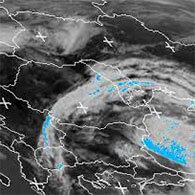WAVE OF NEW REGULATION TOPS INSURANCE SECTOR RISKS - ‘Banana Skins’ poll pinpoints key concerns for insurers
WAVE OF NEW REGULATION TOPS INSURANCE SECTOR RISKS - ‘Banana Skins’ poll pinpoints key concerns for insurers
23 Jul, 2013 12:58
ZIUA de Constanta
 1460
Marime text
1460
Marime text
 1460
Marime text
1460
Marime text
Bucharest, 23 July 2013 – The greatest risk currently facing the insurance industry comes from the wave of new regulations which are being introduced at international and local levels, according to a new survey which ranks insurance sector risk.
The CSFI’s latest Insurance Banana Skins survey, conducted in association with PwC, says that new rules governing issues such as solvency and market conduct could swamp the industry with costs and compliance problems. It could also distract management from the more urgent task of running profitable businesses at a time when the industry is under stress.
The survey polled over 600 insurance practitioners and industry observers in 54 countries to find out where they saw the greatest risks over the next 2-3 years. Regulatory risk emerged a clear leader in many major markets, including North America, Europe, and the Far East/Pacific.
This is the second successive Banana Skins survey which has identified regulation as the top risk concern for insurers, underlining the continuing uncertainty surrounding major regulatory initiatives.
The EU’s Solvency II Directive, now in its seventh year of planning, was the focus of strongest concern, particularly since many non-EU countries are awaiting the outcome before they finalise plans of their own.
A related set of risks lay in the area of business practices (No. 4), another area of regulatory scrutiny. Despite the huge amount that has been done by companies and regulators to clean up practices such as mis-selling, this is still seen as an area of high risk particularly at a time of economic stress when pressure to generate sales is strong.
Other high-ranking concerns revealed by the survey
included the uncertain state of financial markets (No. 2) and the world economy (No. 3). These are adding to the pressures on an industry which has been squeezed by years of low interest rates and intense competition. A particular focus of concern was the legacy of products which offer guaranteed returns but cannot be profitably funded at today’s low yields (No. 6).
The continuation of difficult market conditions has also put the spotlight on the quality of management (No. 8), and particularly risk management (No. 7).
This year’s survey showed continuing concern about underwriting risks in natural catastrophes (No. 5) given the greater frequency of events, and the rising cost of claims. In some markets, such as New Zealand and Australia, the insurers’ handling of catastrophe claims has become a major political issue.
On the other hand, a number of risks have fallen in urgency, notably concern about the availability of capital to sustain the industry (down from No. 2 to No. 16). The situation is now reversed: there is excess capital in the industry, particularly on the non-life and reinsurance sides, which is keeping prices soft and hurting profitability. Another receding risk, at least in developed markets, is human resources: the shake-out in the financial services sector has made it easier to recruit and keep good talent. The situation is harder in emerging markets where qualified talent remains in short supply in many markets.
“It is ironic that the industry’s greatest risks are seen to come from regulation, which is intended to reduce risk, at a time when operating and underwriting conditions are also very hard. It is no surprise that these pressures are reflected in rising concern about the ability of management to handle them”, said David Lascelles, survey editor.
A breakdown of the insurance industry by sector shows the life side specifically concerned about the impact of low interest rates on investment performance, and the task of managing complex and competitive retail distribution networks. On the non-life side, the main concerns are with excess capacity and competitive pricing, along with the impact of surging catastrophe claims. Concerns in the reinsurance sector are mainly with the security of capacity in a highly competitive market.
The Romanian insurance market was hit hard by the economic crisis, and on-going intense price competition affecting both the non-life and life sectors. . The players in the industry are affected by low profitability and losses resulting from products such as mandatory car insurance, which can expose insurers to very high claims. “There is a need to strengthen risk management policies and to improve operational efficiency in order to navigate this period and return to healthy growth”, stated Paul Facer, Financial Services Assurance Partner, PwC Romania.
Notes to Editors:
1. The Insurance Banana Skins survey was conducted in March and April 2013 and is based on 662 responses from 54 countries. The breakdown by type of respondent was:
2. The survey is the latest in the CSFI’s long-running Banana Skins series on financial risk. Previous Insurance Banana Skins surveys were in 2007, 2009 and 2011. It can be downloaded from the CSFI website: www.csfi.org or from the PwC website: www.pwc.com.
3. The CSFI (Centre for the Study of Financial Innovation) is a non-profit think-tank, founded in 1993, which looks at challenges and opportunities for the financial sector. It has an affiliate organisation in New York, the New York CSFI.
About PwC
PwC helps organisations and individuals create the value they’re looking for. We’re a network of firms in 158 countries with more than 180,000 people who are committed to delivering quality in assurance, tax and advisory services. Tell us what matters to you and find out more by visiting us at www.pwc.com/ro
The CSFI’s latest Insurance Banana Skins survey, conducted in association with PwC, says that new rules governing issues such as solvency and market conduct could swamp the industry with costs and compliance problems. It could also distract management from the more urgent task of running profitable businesses at a time when the industry is under stress.
The survey polled over 600 insurance practitioners and industry observers in 54 countries to find out where they saw the greatest risks over the next 2-3 years. Regulatory risk emerged a clear leader in many major markets, including North America, Europe, and the Far East/Pacific.
This is the second successive Banana Skins survey which has identified regulation as the top risk concern for insurers, underlining the continuing uncertainty surrounding major regulatory initiatives.
The EU’s Solvency II Directive, now in its seventh year of planning, was the focus of strongest concern, particularly since many non-EU countries are awaiting the outcome before they finalise plans of their own.
A related set of risks lay in the area of business practices (No. 4), another area of regulatory scrutiny. Despite the huge amount that has been done by companies and regulators to clean up practices such as mis-selling, this is still seen as an area of high risk particularly at a time of economic stress when pressure to generate sales is strong.
Other high-ranking concerns revealed by the survey
included the uncertain state of financial markets (No. 2) and the world economy (No. 3). These are adding to the pressures on an industry which has been squeezed by years of low interest rates and intense competition. A particular focus of concern was the legacy of products which offer guaranteed returns but cannot be profitably funded at today’s low yields (No. 6).
The continuation of difficult market conditions has also put the spotlight on the quality of management (No. 8), and particularly risk management (No. 7).
This year’s survey showed continuing concern about underwriting risks in natural catastrophes (No. 5) given the greater frequency of events, and the rising cost of claims. In some markets, such as New Zealand and Australia, the insurers’ handling of catastrophe claims has become a major political issue.
On the other hand, a number of risks have fallen in urgency, notably concern about the availability of capital to sustain the industry (down from No. 2 to No. 16). The situation is now reversed: there is excess capital in the industry, particularly on the non-life and reinsurance sides, which is keeping prices soft and hurting profitability. Another receding risk, at least in developed markets, is human resources: the shake-out in the financial services sector has made it easier to recruit and keep good talent. The situation is harder in emerging markets where qualified talent remains in short supply in many markets.
“It is ironic that the industry’s greatest risks are seen to come from regulation, which is intended to reduce risk, at a time when operating and underwriting conditions are also very hard. It is no surprise that these pressures are reflected in rising concern about the ability of management to handle them”, said David Lascelles, survey editor.
A breakdown of the insurance industry by sector shows the life side specifically concerned about the impact of low interest rates on investment performance, and the task of managing complex and competitive retail distribution networks. On the non-life side, the main concerns are with excess capacity and competitive pricing, along with the impact of surging catastrophe claims. Concerns in the reinsurance sector are mainly with the security of capacity in a highly competitive market.
The Romanian insurance market was hit hard by the economic crisis, and on-going intense price competition affecting both the non-life and life sectors. . The players in the industry are affected by low profitability and losses resulting from products such as mandatory car insurance, which can expose insurers to very high claims. “There is a need to strengthen risk management policies and to improve operational efficiency in order to navigate this period and return to healthy growth”, stated Paul Facer, Financial Services Assurance Partner, PwC Romania.
Notes to Editors:
1. The Insurance Banana Skins survey was conducted in March and April 2013 and is based on 662 responses from 54 countries. The breakdown by type of respondent was:
| % | |
| Non-life | 35 |
| Life insurance | 26 |
| Reinsurance | 7 |
| Brokers | 6 |
| Observers | 26 |
2. The survey is the latest in the CSFI’s long-running Banana Skins series on financial risk. Previous Insurance Banana Skins surveys were in 2007, 2009 and 2011. It can be downloaded from the CSFI website: www.csfi.org or from the PwC website: www.pwc.com.
3. The CSFI (Centre for the Study of Financial Innovation) is a non-profit think-tank, founded in 1993, which looks at challenges and opportunities for the financial sector. It has an affiliate organisation in New York, the New York CSFI.
About PwC
PwC helps organisations and individuals create the value they’re looking for. We’re a network of firms in 158 countries with more than 180,000 people who are committed to delivering quality in assurance, tax and advisory services. Tell us what matters to you and find out more by visiting us at www.pwc.com/ro
Urmareste-ne pe Grupul de Whatsapp
Comentarii
 Fondul Documentar Dobrogea de ieri și de azi
Fondul Documentar Dobrogea de ieri și de azi








_thumb2.jpg)

























